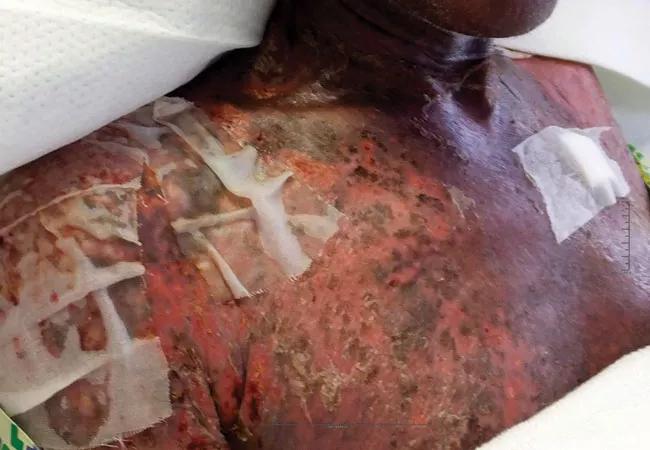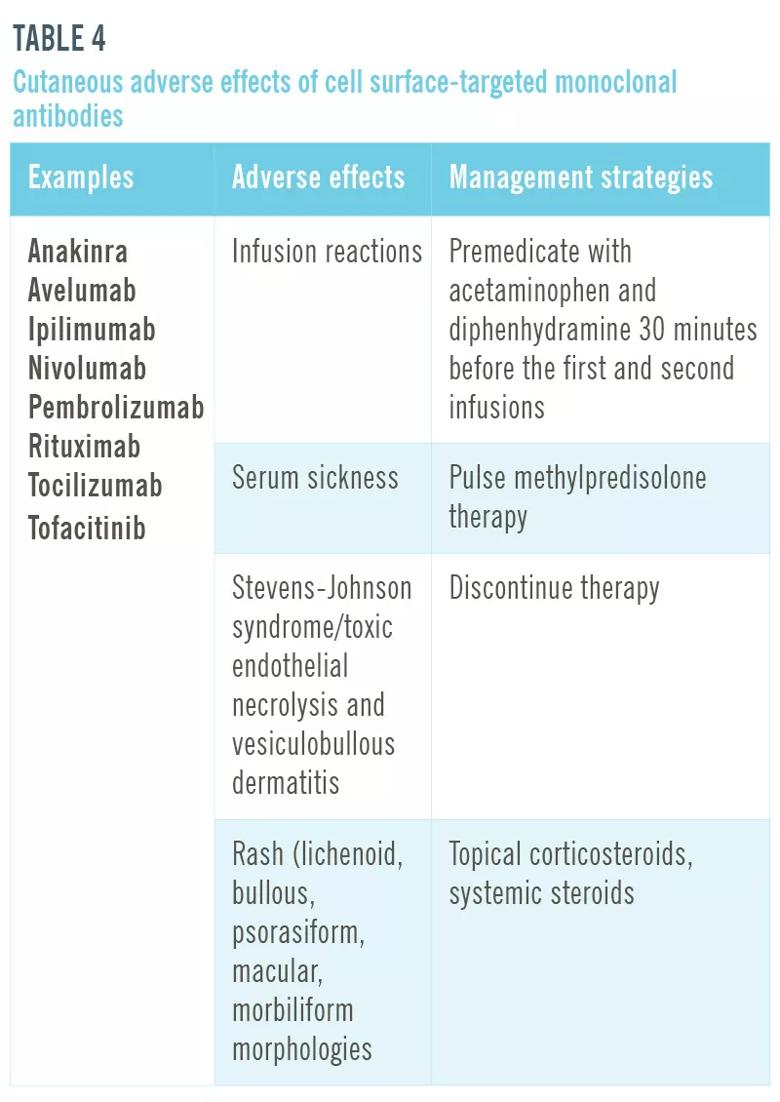by Anthony Fernadez, MD, and Christie Warren, MD
Advertisement
Cleveland Clinic is a non-profit academic medical center. Advertising on our site helps support our mission. We do not endorse non-Cleveland Clinic products or services. Policy
Note: This is an abridged version of an article originally published in the Cleveland Clinic Journal of Medicine.
Biologic therapies have revolutionized medicine and offer targeted therapy for an increasing number of diseases, particularly in rheumatology, gastroenterology, hematology/oncology and dermatology. But along with these advances and their ensuing expanded use have come many unique adverse effects.
Some of the most commonly reported adverse effects with these new therapies are cutaneous, and can potentially limit the use of these agents and add cost to already expensive treatment regimens.1
It is important for physicians and other healthcare providers to be aware of these effects, have a basic understanding of how to manage patients with these reactions, and to know when to refer to a dermatologist. This is the final article of a four-part series that reviews recent literature on cutaneous adverse reactions experienced with commonly prescribed biologic and targeted therapies.
Cell surface-targeted monoclonal antibodies
Monoclonal antibodies are drugs directed against specific antigens on cells that cause disease. These drugs may assist in immune modulation, cell killing or blocking a physiologic ligand-receptor interaction. Not surprisingly, monoclonal antibodies are used in the treatment of immunologic diseases and cancer therapy. Although the number of monoclonal antibodies designed as drugs has been increasing substantially since 1985, common ones include rituximab, anakinra, tocilizumab, ipilimumab, nivolumab, pembrolizumab, avelumab and tofacitinib.
Rituximab, an anti-CD20 monoclonal antibody
Rituximab is a chimeric murine-human monoclonal antibody against CD20 used in rheumatoid arthritis, autoimmune disorders and lymphoproliferative disorders. While dermatologically it is relatively benign, it has been reported to cause infusion reactions. Standard practice is to premedicate with acetaminophen and diphenhydramine 30 minutes before the first and second infusions.
Serum sickness has also been reported with rituximab, and is seen visibly as a morbilliform skin eruption with acral accentuation.35 Treatment for this reaction includes pulse methylprednisolone therapy, which can be effective in resolving symptoms over 48 hours.
Less commonly, Stevens-Johnson syndrome-toxic epidermal necrolysis and vesiculobullous dermatitis can occur with rituximab, in which case discontinuation is recommended.
Other monoclonal antibodies
Other commonly used monoclonal antibodies include anakinra, tocilizumab and ipilimumab.
Anakinra is a recombinant human interleukin 1 receptor antagonist used to treat rheumatoid arthritis, systemic juvenile idiopathic arthritis, adult-onset Still disease, and, in select patients, recurrent pericarditis. Case reports note new-onset psoriasis with this drug, as well as injection-site reactions.36
Tocilizumab is an anti-human interleukin 6 receptor antibody used for rheumatoid arthritis and giant cell arteritis. It rarely presents with skin rash, but is most notable for hypersensitivity reactions upon infusion.37
Ipilimumab is a monoclonal antibody directed against cytotoxic T-lymphocyte antigen 4 used to treat patients with advanced melanoma.
In 41 patients treated with ipilimumab, 34.1% developed cutaneous adverse events that included rash (7.3%), folliculitis (7.3%), mucositis (2.4%), rosacea (2.4%), eczema (2.4%), acneiform eruption (2.4%), syringometaplasia mucinosa (2.4%;), Stevens-Johnson syndrome (2.4%) and vitiligo (4.9%). Approximately 5% of the patients complained of severe xerosis and 10% of pruritus.38
Treatment for these cutaneous manifestations is similar to that described in previous sections.
Nivolumab, pembrolizumab and avelumab bind to programmed cell death ligand-1 (PD-L1), enhancing the host immune response by preventing tumor cells from suppressing endogenous T-cell activity. Cutaneous eruptions described with these medications include lichenoid, bullous, psoriasiform, macular and morbilliform morphologies. Cases of Stevens-Johnson syndrome-toxic epidermal necrolysis (as pictured above) have also been reported.
Treatment with topical corticosteroids, systemic steroids, or discontinuation of the anti-PD-L1 inhibitor may be effective depending on the severity of the eruption.39
Be on the lookout
Biologic medications are becoming critical in medicine, for treating conditions ranging from autoimmune diseases to metastatic cancers. They are reducing mortality and substantially improving quality of life.
It is therefore important that physicians be armed with knowledge about the cutaneous adverse events of these medications and basic treatment steps. For example, knowing when to reduce the dose or discontinue the drug, supplement with topical or oral steroids or antibiotics, or refer to a dermatologist will be highly useful when caring for patients on these biologics. These innovative medications will only reach their maximum effectiveness when we as providers understand and manage adverse events appropriately.
References
- Treudler R. New drug therapies and their effect on the skin. J Dtsch Dermatol Ges. 2009; 7(7):623–637.
- Steenholdt C, Svenson M, Bendtzen K, Thomsen O, Brynskov J, Ainsworth M. Severe infusion reactions to infliximab: aetiology, immunogenicity and risk factors in patients with inflammatory bowel disease. Aliment Pharmacol Ther. 2011; 34(1):51–58.
- AbbVie, Inc. HUMIRA (adalimumab) injection, for subcutaneous use. Highlights of prescribing information. www.accessdata.fda.gov/drugsatfda_docs/label/2017/125057s399lbl.pdf. Accessed April 7, 2020.
- Capogrosso Sansone A, Mantarro S, Tuccori M, et al. Safety profile of certolizumab pegol in patients with immune-mediated inflammatory diseases: a systematic review and meta-analysis. Drug Saf. 2015; 38(10):869–888.
- Fréling E, Baumann C, Cuny JF, et al. Cumulative incidence of, risk factors for, and outcome of dermatological complications of anti-TNF therapy in inflammatory bowel disease: a 14-year experience. Am J Gastroenterol. 2015; 110(8):1186–1196.
- Hernández MV, Sanmartí R, Cañete JD, et al; BIOBADASER 2.0 Study Group. Cutaneous adverse events during treatment of chronic inflammatory rheumatic conditions with tumor necrosis factor antagonists: study using the Spanish registry of adverse events of biological therapies in rheumatic diseases. Arthritis Care Res (Hoboken). 2013; 65(12):2024–2031.
- Mocci G, Marzo M, Papa A, Armuzzi A, Guidi L. Dermatological adverse reactions during anti-TNF treatments: focus on inflammatory bowel disease. J Crohns Colitis. 2013; 7(10):769–779.
- Kane S, Khatibi B, Reddy D. Higher incidence of abnormal Pap smears in women with inflammatory bowel disease. Am J Gastroenterol. 2008; 103(3):631–636.
- George LA, Gadani A, Cross RK, Jambaulikar G, Ghazi LJ. Psoriasiform skin lesions are caused by anti-TNF agents used for the treatment of inflammatory bowel disease. Dig Dis Sci. 2015; 60(11):3424–3430.
- Mazloom SE, Yan D, Hu JZ, et al. TNF-a inhibitor-induced psoriasis: a decade of experience at the Cleveland Clinic. J Am Acad Dermatol. 2018. doi:10.1016/j.jaad.2018.12.018. Epub ahead of print.
- Li SJ, Perez-Chada LM, Merola JF. TNF inhibitor-induced psoriasis: proposed algorithm for treatment and management. J Psoriasis Psoriatic Arthritis. 2019; 4(2):70–80.
- Cleynen I, Van Moerkercke W, Billiet T, et al. Characteristics of skin lesions associated with anti-tumor necrosis factor therapy in patients with infl ammatory bowel disease: a cohort study. Ann Intern Med. 2016; 164(1):10–22.
- Ramos-Casals M, Brito-Zerón P, Soto MJ, Cuadrado MJ, Khamashta MA. Autoimmune diseases induced by TNF-targeted therapies. Best Pract Res Clin Rheumatol. 2008; 22(5):847–861.
- Mariette X, Matucci-Cerinic M, Pavelka K, et al. Malignancies associated with tumour necrosis factor inhibitors in registries and prospective observational studies: a systematic review and meta-analysis. Ann Rheum Dis. 2011; 70(11):1895–1904.
- Scott FI, Mamtani R, Brensinger CM, et al. Risk of nonmelanoma skin cancer associated with the use of immunosuppressant and biologic agents in patients with a history of autoimmune disease and nonmelanoma skin cancer. JAMA Dermatol 2016; 152(2):164–172.
- Mercer LK, Askling J, Raaschou P, et al. Risk of invasive melanoma in patients with rheumatoid arthritis treated with biologics: results from a collaborative project of 11 European biologic registers. Ann Rheum Dis. 2017; 76(2):386–391.
- Fabbrocini G, Panariello L, Caro G, Cacciapuoti S. Acneiform rash induced by EGFR inhibitors: review of the literature and new insights. Skin Appendage Disord. 2015; 1(1):31–37.
- Busam KJ, Capodieci P, Motzer R, Kiehn T, Phelan D, Halpern AC. Cutaneous side-effects in cancer patients treated with the antiepidermal growth factor receptor antibody C225. Br J Dermatol. 2001; 144(6):1169–1176.
- Jatoi A, Nguyen PL. Do patients die from rashes from epidermal growth factor receptor inhibitors? A systematic review to help counsel patients about holding therapy. Oncologist. 2008; 13(11):1201– 1204.
- Druker BJ, Talpaz M, Resta DJ, et al. Effi cacy and safety of a specific inhibitor of the BCR-ABL tyrosine kinase in chronic myeloid leukemia. N Engl J Med. 2001; 344(14):1031–1037.
- Kantarjian H, Sawyers C, Hochhaus A, et al; International STI571 CML Study Group. Hematologic and cytogenetic responses to imatinib mesylate in chronic myelogenous leukemia. N Engl J Med. 2002; 346(9):645–652.
- Heidary N, Naik H, Burgin S. Chemotherapeutic agents and the skin: an update. J Am Acad Dermatol. 2008; 58(4):545–570.
- Kantarjian H, Giles F, Wunderle L, et al. Nilotinib in imatinib-resistant CML and Philadelphia chromosome-positive ALL. N Engl J Med. 2006; 354(24):2542–2551.
- Cortes JE, Kantarjian HM, Brümmendorf TH, et al. Safety and efficacy of bosutinib (SKI-606) in chronic phase Philadelphia chromosomepositive chronic myeloid leukemia patients with resistance or intolerance to imatinib. Blood. 2011; 118(17):4567–4576.
- Abdel-Rahman O, Fouad M. Risk of mucocutaneous toxicities in patients with solid tumors treated with sunitinib: a critical review and meta analysis. Expert Rev Anticancer Ther. 2015; 15(1):129–141.
- Strumberg D, Awada A, Hirte H, et al. Pooled safety analysis of BAY 43-9006 (sorafenib) monotherapy in patients with advanced solid tumours: is rash associated with treatment outcome? Eur J Cancer. 2006; 42(4):548–556.
- Arnault JP, Wechsler J, Escudier B, et al. Keratoacanthomas and squamous cell carcinomas in patients receiving sorafenib. J Clin Oncol. 2009; 27(23):e59–e61.
- Sternberg CN, Davis ID, Mardiak J, et al. Pazopanib in locally advanced or metastatic renal cell carcinoma: results of a randomized phase III trial. J Clin Oncol. 2010; 28(6):1061–1068.
- Fischer A, Wu S, Ho AL, Lacouture ME. The risk of hand-foot skin reaction to axitinib, a novel VEGF inhibitor: a systematic review of literature and meta-analysis. Invest New Drugs. 2013; 31(3):787–797.
- Wells SA Jr, Gosnell JE, Gagel RF, et al. Vandetanib for the treatment of patients with locally advanced or metastatic hereditary medullary thyroid cancer. J Clin Oncol. 2010; 28(5):767–772.
- Hsiao YW, Lin YC, Hui RC, Yang CH. Fulminant acneiform eruptions after administration of dovitinib in a patient with renal cell carcinoma. J Clin Oncol. 2011; 29(12):e340–e341.
- Chapman PB, Hauschild A, Robert C, et al; BRIM-3 Study Group. Improved survival with vemurafenib in melanoma with BRAF V600E mutation. N Engl J Med. 2011; 364(26):2507–2516.
- Ascierto PA, Minor D, Ribas A, et al. Phase II trial (BREAK-2) of the BRAF inhibitor dabrafenib (GSK2118436) in patients with metastatic melanoma. J Clin Oncol. 2013; 31(26):3205–3211.
- Blechman AB, Cabell CE, Weinberger CH, et al. Aggressive skin cancers occurring in patients treated with the Janus kinase inhibitor ruxolitinib. J Drugs Dermatol. 2017; 16(5):508–511.
- Guan M, Zhou YP, Sun JL, Chen SC. Adverse events of monoclonal antibodies used for cancer therapy. Biomed Res Int. 2015; 2015:428169.
- Vila AT, Puig L, Fernández-Figueras MT, Laiz AM, Vidal D, Alomar A. Adverse cutaneous reactions to anakinra in patients with rheumatoid arthritis: clinicopathological study of fi ve patients. Br J Dermatol. 2005; 153(2):417–423.
- Rocchi V, Puxeddu I, Cataldo G, et al. Hypersensitivity reactions to tocilizumab: role of skin tests in diagnosis. Rheumatology (Oxford). 2014; 53(8):1527–1529.
- Dika E, Ravaioli GM, Fanti PA, et al. Cutaneous adverse effects during ipilimumab treatment for metastatic melanoma: a prospective study. Eur J Dermatol. 2017; 27(3):266–270.
- Shen J, Chang J, Mendenhall M, Cherry G, Goldman JW, Kulkarni RP. Diverse cutaneous adverse eruptions caused by anti-programmed cell death-1 (PD-1) and anti-programmed cell death ligand-1 (PD-L1) immunotherapies: clinical features and management. Ther Adv Med Oncol. 2018; 10:1758834017751634.








